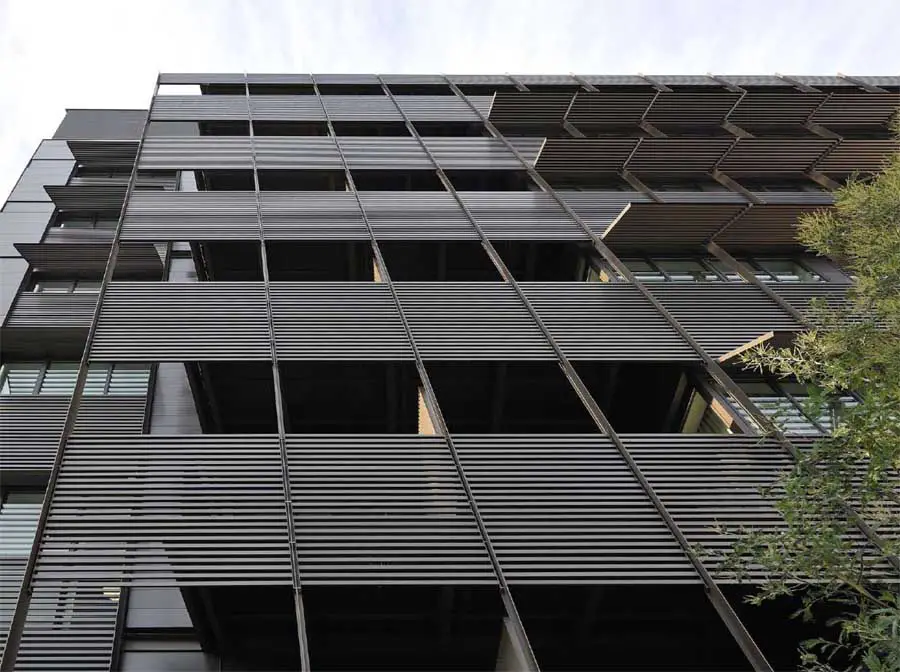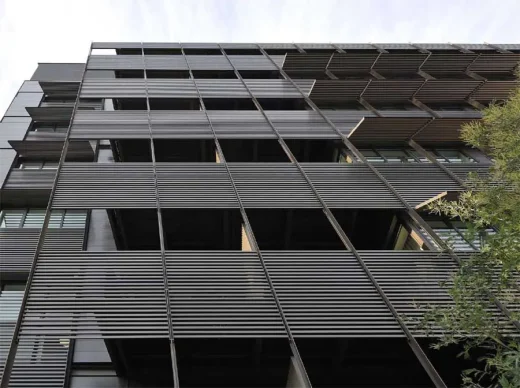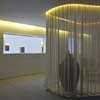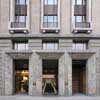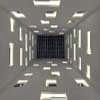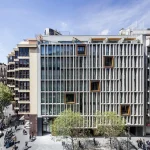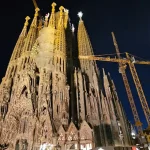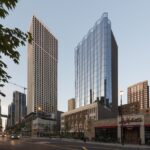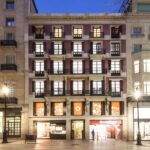Hotel Mandarin Barcelona, Paseo de Gracia accommodation building photos, Spanish design
Hotel Mandarin Oriental Barcelona
Accommodation in Catalonia design by Carlos Ferrater y Juan Trias de Bes, Spain
Design: OAB Office of Architecture
Hotel Mandarin Oriental Barcelona
Photos by Dani Rovira
19 Jan 2010
Hotel Mandarin ****** in the Paseo de Gracia, Barcelona
We design a longitudinal axis, which connects the building from the street to the interior of the city block. This axis is an itinerary that extends over the following sequence:
1. The Paseo de Gracia: From where access takes place.
2. The facade:
The facade does not conform to the Modernista (Art Nouveau) landscape of the Paseo de Gracia, but has respected its memory. The intervention has consisted of preserving its main order, but has eliminated all superfluous ornamentation.
3. The entrance portico:
The only intervention of importance has concentrated on opening up the windows of the ground floor in order to create an entrance portico, the aim being to obtain permeability from the Paseo towards the interior, inviting access.
4. The access ramp:
The main access is via an aerial walkway that offers an ascending route, eliminating the original entrance with its descending imperial staircase. This operation provides an “optimistic” entrance and permits arrival in a more centered position of the building, thereby resolving the circulatory system within.
5. The atrium lightwell:
While crossing the entrance ramp one discovers the atrium lightwell.
The illumination is natural and artificial.
The first is produced by a glass skylight.
The second, by the geometrical slippage of the window frames of the access corridors to the rooms.
This solution provides continuity in spatial and sensory perception between day and night.
It also offers a scenic entrance that marks the sequence of the transition between exterior and interior.
6. Arrival at the mezzanine level:
The entrance to the closed area of the hotel is situated on the mezzanine floor. From this distributor all the accesses to the different areas of the hotel are resolved.
From here one discovers the double space of the former trading floor of the bank.
7. The former trading floor:
This space has been recreated with a new structure and natural overhead lighting, and is devoted to the hotel’s more public areas: lounges, restaurants and cafeteria.
8. The interior of the block:
The roof of the former trading floor forms the garden-terrace in the interior of the block, with the collaboration of Beth Figueras.
9. The interior facade:
The intervention consists in providing a “veil” for the original structure of the building, conserving its volumetry.
A system of metal ribs permits visual and light control.
10. The corridor-ambulatory:
Access to the bedrooms is produced by means of an interior ambulatory, which is in fact the interior facade of the atrium lightwell. In this way one has a new perception of this great space. If when crossing the ramp the view is global and complete, from the inside it is fragmented and kinetic.
11. The roof:
With its clean, geometric and compact volumetry, the roof brings together an immense number of service elements. Furthermore, the solution of the section also provides a platform- vantage point over the city.
A sheet of water and a strip of vegetation distance the visitor from the vertical plane of the facade and contribute to offsetting the inhospitable effect of very high roofs.
Photographs : Dani Rovira
Hotel Mandarin Oriental Barcelona : main page
The program
Of a total of 17,000 m2, the ground floor of the hotel is meant for the main lounge (1,300 m2), but will combine cafeteria and restaurant uses in the same space. A system of sliding doors will permit small meeting rooms to be closed off for business events.
One kitchen is found on the ground floor for the restaurant and cafeteria, and the other on the mezzanine floor for gourmet cuisine. Found on the mezzanine level of the former trading floor are the hotel’s more exclusive and private spaces. From the mezzanine level one can accede via the stairs situated in each of its side patios to the roof on the first floor, destined for the garden terrace of more than 600 m2.
The surface area of the first basement level (2,400 m2) is divided up between those uses intended for the personnel, such as offices, a changing facility, restaurant, laundry and merchandizing control, and a huge spa of more than 1,000 m2, with changing rooms for the clients, a climate-controlled indoor swimming pool, a fitness area and cabins for all kinds of therapies and treatments.
The second basement level (2,400 m2) is devoted to all the installations and storage areas of the hotel. On this basement level are also found the servers of the hotel’s entire computer system, the swimming pool machinery and the distributors of the electrical circuits. Coldstorage rooms for the kitchen and for the refuse have also been planned. It has to be borne in mind that the Paseo de Gracia has a highly restricted early-morning timetable for loading and unloading. As a result, a way has been devised to permit the logistics of this to work by means of a palletization system that will be put into effect off the hotel premises.
The 102 bedrooms of the hotel are found between the first and the eighth floors. On each floor one accedes from two entrance cores, one for clients, the other for room service.
Situated on the ninth floor is the presidential suite of almost 200 m2. On the roof is the open-air swimming pool, with separate entrances for service personnel and clients. Access by elevator makes the roof an ideal spot—some 300 m2 in size—for organizing special events or parties.
Finally, on the roof are found the hotel’s more voluminous installations. These are large cooling plants to provide climate control for the bedrooms, groups of electricity generators in case the building’s electricity supply is interrupted, a gondola for cleaning the interior atrium, the boilers and tanks for producing sanitary hot water, the solar energy-collecting panels, the outlets of conduits from kitchen hoods and ventilation systems, etc.
The general description of the program is of use to understand the difficulty of siting a state-of-the-art hotel program in a building from the Spanish post-Civil War period.
The material aspects
The main facade is of light beige “Figueres” limestone. Since supplies of this kind of stone are no longer to be had, fragments of the actual building have been utilized to make the necessary repairs.
The frames of the windows on the Paseo de Gracia facade are of natural bronze.
All the same, sound and thermal insulation must be installed to optimum standards.
To do this, we have used as a base an aluminum profile system approved for such an end and this has been coated with bronze by means of a mechanized system specific to this project.
The profile system of the display windows and access to the ground-floor premises are of solid sulphurated brass. They reach a height of five meters. In the profile system the glass rebates are resolved by means of milling.
The rear facade consists entirely of different profile systems of solid extruded aluminum designed especially for this facade. This involves a framework system that provides a response to the different types of galleries, balconies and windows. It consists of T-section profiles, slats of variable section and inclination, and angled sheets to resolve the different heights of the main floors.
All the aluminum is lacquered in a bronze color specific to the building.
The inner facade of the atrium is a system of mutually sliding steel frames. In order to
allow for the thickness of the existing structure, a geometric “game” has been designed that permits the atrium to be illuminated via the actual elements of the windows. This is a simple constructional solution of sheets of plasterboard with damp-resistant properties, finished in white.
The paving of the flat roof on the first floor is of dark gray, striated, “Cumella” sandstone. This means “rehabilitating” ceramic on the interior of the block, but with contemporary properties. On the same flat roof we have set out a series of large stainless-steel skylights, respecting the original structure of the building.
Carlos Ferrater Juan Trias de Bes, Barcelona
Hotel Mandarin Barcelona information from OAB Office of Architecture
Hotel Mandarin Oriental Barcelona design : Carlos Ferrater
Location: Paseo de Gracia, Barcelona, Catalonia, Spain
Architecture in Barcelona
Contemporary Architecture in Barcelona
Barcelona Architecture Walking Tours
Barcelona Hotels
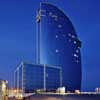
image from architect
La Mola Hotel, Terrassa, Barcelona
Fermín Vázquez – b720 Arquitectos
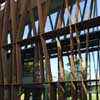
photo : Joan Argelés
Hotel Diagonal Barcelona
Capella Garcia Arquitectura
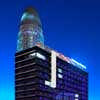
image from architect
Nou Camp Stadium Competition
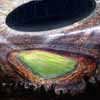
image : Foster + Partners
Comments / photos for the Hotel Mandarin Oriental Barcelona Architecture page welcome
Architecture Walking Tours – city walks

